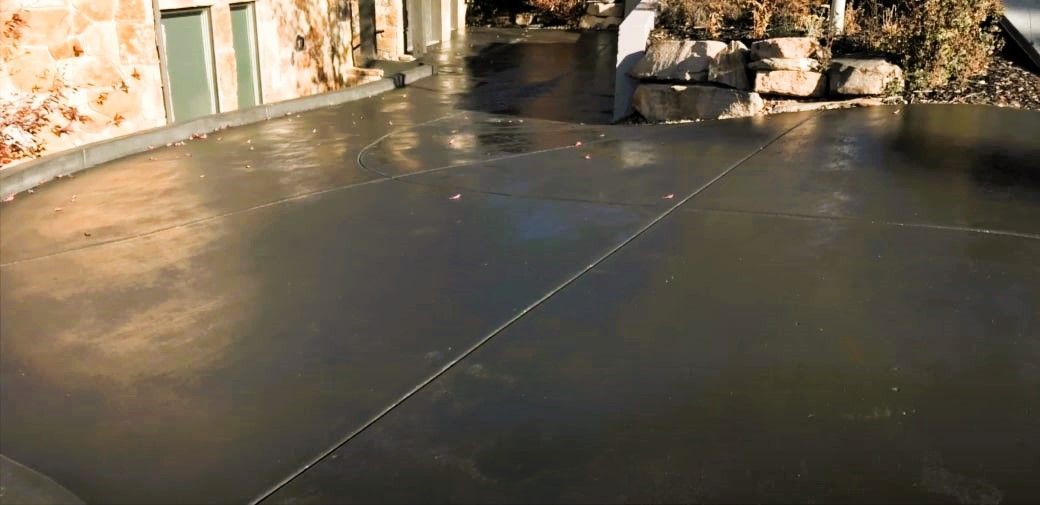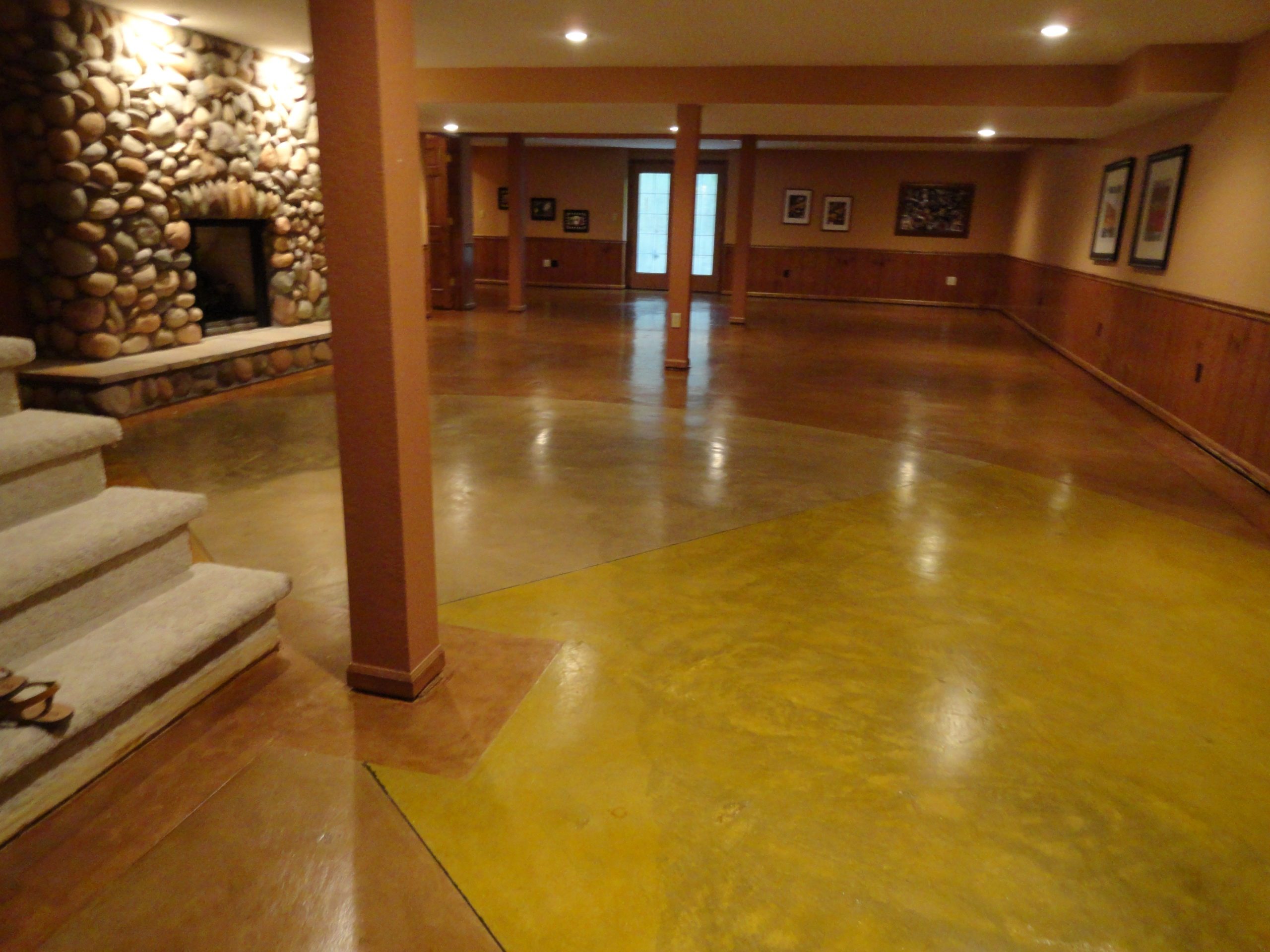Best practices for caring for stained concrete floors
Everything About Stained Concrete: A Comprehensive Guide to Its Benefits and Applications
Stained concrete has emerged as a popular choice for both domestic and industrial areas. Its ability to integrate visual appeal with usefulness makes it an appealing option. Numerous staining methods use a variety of colors and coatings, enabling for personalization. The benefits prolong past appearance. Recognizing its applications and maintenance needs is vital for any person considering this flexible product. The subtleties of stained concrete invite even more exploration.
What Is Stained Concrete?

Staining can be put on different surface areas, consisting of floors, driveways, and patios, making it a functional choice for both indoor and exterior areas. The therapy can achieve a series of appearances, from earthy tones to strong, modern styles. Unlike paint, stained concrete maintains its look over time, as it comes to be an important part of the concrete itself. Overall, stained concrete acts as an efficient approach for changing average concrete right into visually striking surfaces.
Advantages of Stained Concrete
Stained concrete deals considerable benefits, especially in visual allure and toughness - stained concrete. Its vibrant shades and one-of-a-kind patterns enhance the visual beauty of any space, making it a popular selection for both residential and commercial applications. In addition, the longevity of stained concrete warranties that it stays a functional financial investment over time, resisting wear and tear
Aesthetic Appeal
One of one of the most engaging advantages of utilizing stained concrete is its amazing aesthetic appeal. Stained concrete offers an one-of-a-kind and functional look that can enhance various design styles, from modern-day to rustic. The mixture of lively shades and intricate patterns allows house owners and developers to produce personalized surfaces that can boost the general ambiance of an area. Unlike conventional floor covering alternatives, stained concrete can mimic the look of natural rock or polished marble, supplying an upscale look without the connected prices. Furthermore, the glossy finish alternatives can mirror light, additional brightening interiors. This versatility makes stained concrete a preferred choice for both property and business applications, where aesthetic effect is critical.
Resilience and Longevity
The excellent aesthetic high qualities of stained concrete are complemented by its impressive resilience and long life - stained concrete floors. Stained concrete surfaces are immune to deterioration, making them suitable for high-traffic locations both inside your home and outdoors. Their durable nature implies they can hold up against severe weather problems, including severe temperature levels, rainfall, and UV exposure, without considerable deterioration. In addition, stained concrete needs very little upkeep compared to other floor covering choices, as it does not require frequent sealing or refinishing. This durability not just reduces substitute prices however additionally adds to a lasting structure approach. On the whole, stained concrete offers an enduring service that incorporates aesthetic charm with practical advantages, ensuring its value gradually
Various Kinds Of Staining Techniques
Different staining techniques can markedly influence the visual qualities of concrete surface areas. The 3 primary methods consist of acid discoloration, which reacts chemically with the concrete, water-based discoloration, which offers a broader series of colors, and overlay staining alternatives that give a fresh surface area. Each method has special characteristics and applications that accommodate numerous design choices and task needs.
Acid Discoloration Technique
Just how can homeowners change simple concrete surface areas into aesthetically striking attributes? One effective approach is acid discoloration, a preferred method that enhances the all-natural beauty of concrete. This procedure includes applying a remedy of water, hydrochloric acid, and metal salts to the concrete surface. As the acid responds with the lime existing in the concrete, it produces abundant, variegated shades that look like marble or rock. Acid staining is known for its longevity and resistance to fading, making it a durable selection for both indoor and outdoor applications. Nevertheless, it is necessary to keep in mind that the outcomes can vary based upon the initial concrete color and structure - stained concrete floors. Appropriate application and sealing are vital for accomplishing the preferred aesthetic and durability
Water-Based Staining Technique
A prominent choice to acid discoloration, the water-based discoloration strategy supplies house owners a flexible means to enhance concrete surfaces. This technique uses water-soluble dyes and pigments, enabling a large range of shades and coatings. Unlike acid spots, water-based stains can be related discover here to unsealed concrete and supply a less complicated clean-up procedure. The results can accomplish a much more consistent appearance and can be layered to create distinct results. Furthermore, water-based discolorations are generally less toxic and emit fewer volatile natural substances (VOCs), making them much more eco-friendly. Homeowners might value the capability to customize their concrete surfaces with different shades, enabling for imaginative expression while keeping toughness and longevity in their floor covering options.
Overlay Staining Options
Many overlay staining choices exist for property owners seeking to renew their concrete useful content surface areas. One prominent choice is acid discoloration, which responds chemically with the concrete to generate abundant, variegated shades. One more option is water-based discoloration, providing a wider shade combination and simpler application. Additionally, concrete overlays can be integrated with patterns for complex styles, enhancing aesthetics. For a much more textured surface, homeowners may think about using stamped overlays that simulate all-natural materials like rock or floor tile. Each method supplies one-of-a-kind benefits, from longevity to modification, permitting for an individualized touch. Ultimately, the selection of overlay discoloration relies on the wanted appearance and the condition of the existing concrete, making sure a refreshed and enticing surface area.
Applications of Stained Concrete
Stained concrete deals a functional solution for numerous applications, improving both aesthetic allure and performance. This product is generally used in property, commercial, and industrial settings, making it a popular option amongst architects and designers. In homes, stained concrete can act as elegant floor covering or outside patio areas, offering an innovative look while staying sturdy.
In industrial areas, such as retailers and dining establishments, stained concrete adds to a contemporary ambiance and can withstand hefty foot web traffic. In addition, stained concrete is increasingly utilized in public rooms like parks and pathways, where its ability to resemble all-natural rock or various other products includes aesthetic rate of interest.
Furthermore, stained concrete is suitable for pool decks and driveways, supplying a slip-resistant surface area that is simple to maintain. In general, the flexibility of stained concrete makes it ideal for many environments, accommodating diverse tastes and demands.
Upkeep and Look After Stained Concrete
Proper upkeep ensures the durability and charm of stained concrete surfaces. Regular cleaning is necessary; utilizing a mild cleaning agent and water with a soft-bristle brush aids eliminate dust and crud without damaging the surface. It is advisable to stay clear of severe chemicals that can remove the tarnish or sealer.
Sealing stained concrete is vital for security against dampness, stains, and wear. A high-quality sealer should be reapplied every one to 3 years, depending on the web traffic and direct exposure the surface withstands. Furthermore, resolving spills promptly will prevent discoloration and discoloration.

Cost Considerations for Stained Concrete Projects
When intending a tarnished concrete job, budget plan factors to consider play a crucial role in figuring out the total price. The expenses related to stained concrete can differ considerably based on numerous aspects. The dimension of the area to be stained directly influences material and labor prices. Bigger spaces will naturally need more sources. Second, the type of tarnish selected-- acid-based or water-based-- can influence rates, with acid stains frequently being much more pricey. Furthermore, the intricacy of the design, including patterns or numerous shades, can enhance labor expenses. Preparation work, such as cleaning and grinding the concrete surface area, adds to the preliminary expenditures as well. The choice in between DIY installment and working with a specialist specialist will further impact the budget. Recognizing these elements allows homeowners to make educated financial choices regarding their stained concrete jobs, ensuring they achieve the desired aesthetic within their financial means.
Tips for Picking the Right Stained Concrete for Your Area
Picking the appropriate stained concrete for a certain area entails careful contemplation of different aspects past simply budget. First, one need to assess the desired use the location. High-traffic zones may need even more durable surfaces, while decorative applications can focus on looks.
The shade combination is another important aspect; the selected colors ought to integrate with existing design and illumination. It's also essential to take right into account the surface texture, as smooth coatings can improve sophistication, while distinctive alternatives might ensure safety and security in damp areas.
Local climate and environmental problems play a significant role in the longevity and upkeep of stained concrete, affecting the selection of sealants and surfaces.
Ultimately, speaking with experts can provide valuable understandings customized to specific needs, ensuring the option of the optimal stained concrete that aligns with both capability and style.

Often Asked Questions
Can Stained Concrete Be Applied Over Existing Floor Covering?
Stained concrete can certainly be applied over existing floor covering, provided the surface is steady and properly prepared. This method allows for a visual upgrade without the need for complete elimination of the initial floor covering materials.
The Length Of Time Does Stained Concrete Last?
Stained concrete can last for years when appropriately preserved. Variables such as traffic, ecological conditions, and application techniques significantly affect its durability, with lots of installations continuing to be vivid and undamaged for 10 to 30 years.
Is Stained Concrete Slippery When Wet?
Stained concrete can be unsafe when wet, as the coating may produce a smooth surface area. Utilizing non-slip additives or distinctive finishes can minimize this problem, enhancing safety without compromising the aesthetic charm of the concrete.
Can I Tarnish Concrete Myself, or Should I Work with an Expert?
The decision to tarnish concrete personally or hire a professional rest on skill level and project complexity. While DIY discoloration can conserve money, specialists ensure suitable results, especially for complex layouts or big surfaces.
What Color styles Are Available for Stained Concrete?
The range of shades readily available for stained concrete includes earthy tones like browns and tans, vivid shades such as reds and blues, and softer shades like pastels. This combination allows for innovative, personalized design options.